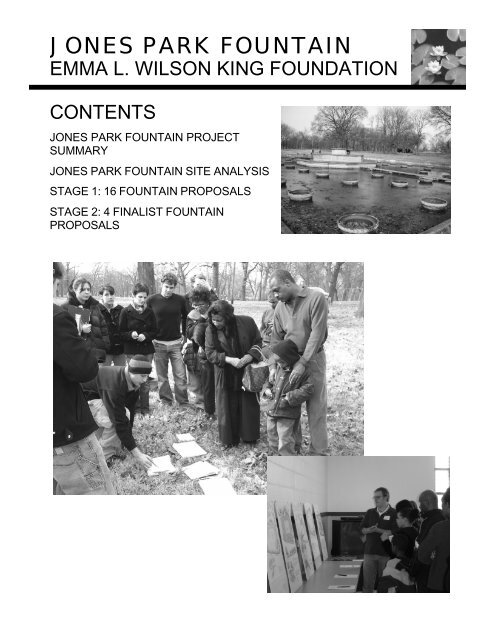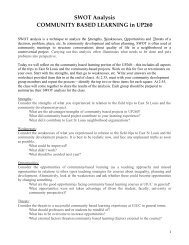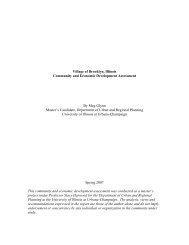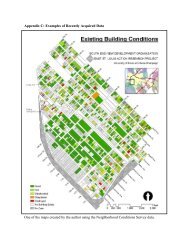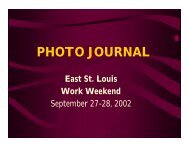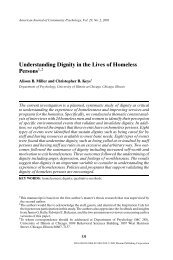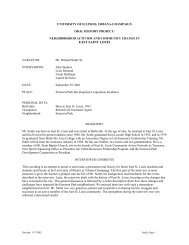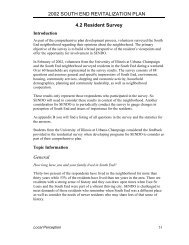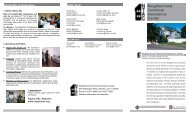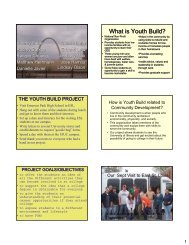jones park fountain - East St. Louis Action Research Project
jones park fountain - East St. Louis Action Research Project
jones park fountain - East St. Louis Action Research Project
You also want an ePaper? Increase the reach of your titles
YUMPU automatically turns print PDFs into web optimized ePapers that Google loves.
JONES PARK FOUNTAIN<br />
EMMA L. WILSON KING FOUNDATION<br />
CONTENTS<br />
JONES PARK FOUNTAIN PROJECT<br />
SUMMARY<br />
JONES PARK FOUNTAIN SITE ANALYSIS<br />
STAGE 1: 16 FOUNTAIN PROPOSALS<br />
STAGE 2: 4 FINALIST FOUNTAIN<br />
PROPOSALS
JONES PARK FOUNTAIN<br />
EMMA L. WILSON KING FOUNDATION<br />
Jones Park: Emma L. Wilson King Foundation Fountain Design<br />
The Emma L. Wilson King Foundation was created in memory of Emma King, an<br />
active member of the <strong>East</strong> <strong>St</strong>. <strong>Louis</strong> community. Her husband and twelve children formed<br />
the foundation in 2005. The foundation decided to commemorate her legacy by<br />
rehabilitating the Jones Park lily pond/ <strong>fountain</strong>.<br />
The foundation contacted University of Illinois landscape architect students who<br />
were working with the <strong>East</strong> <strong>St</strong>. <strong>Louis</strong> <strong>Action</strong> <strong>Research</strong> <strong>Project</strong> (ESLARP), an<br />
organization that is dedicated to the revitalization of <strong>East</strong> <strong>St</strong>. <strong>Louis</strong>. The design process<br />
began with a site visit and meeting with family members of Mrs. King. While on site,<br />
students quickly presented preliminary design ideas to the family. <strong>St</strong>udents took<br />
feedback from the family and later created 16 individual designs based on their<br />
comments.<br />
From those 16 original designs, four were chosen as finalists for the <strong>fountain</strong><br />
design. Those four finalists then began working on revisions and further analysis of their<br />
designs. Several weeks later, the foundation met for the final presentations of the design<br />
project where one of the four designs would be chosen for future development and<br />
installation.
JONES PARK FOUNTAIN<br />
EMMA L. WILSON KING FOUNDATION<br />
SITE ANALYSIS<br />
Site Information: Jones Park is located north of Interstate 64 and across from the Jackie<br />
Joyner Kersee Center in <strong>East</strong> <strong>St</strong>. <strong>Louis</strong>, IL. The <strong>park</strong> is one of the larges in <strong>East</strong> <strong>St</strong>. <strong>Louis</strong><br />
and is a major feature for the Lansdowne neighborhood. Within the <strong>park</strong> there is a track,<br />
baseball diamonds, a large pond, a lily pool and <strong>fountain</strong>, and a pavilion. The <strong>East</strong> <strong>St</strong>.<br />
<strong>Louis</strong> walking and biking trail runs through Jones Park and there are several main tree<br />
species throughout the <strong>park</strong> including Bald cypress, Sycamore, Ginkgo, Chinese elm, and<br />
a variety of oak trees. The site focus is on the lily pond, located in the southwest corner<br />
of the <strong>park</strong>, adjacent to the <strong>park</strong>’s main road, surrounding houses, and a baseball<br />
diamond. There is a gravel <strong>park</strong>ing lot north of the <strong>fountain</strong> along the main <strong>park</strong> road.
JONES PARK FOUNTAIN<br />
EMMA L. WILSON KING FOUNDATION<br />
STAGE 1: 16 FOUNTAIN DESIGN PROPOSALS<br />
Wife<br />
Mother<br />
Friend<br />
Neighbor<br />
COLLEEN HAHN<br />
MATT COLBY<br />
Community<br />
Education<br />
Spirituality<br />
Gardening<br />
RYAN<br />
BORDEWICK<br />
TIM SLAZINIK
JONES PARK FOUNTAIN<br />
EMMA L. WILSON KING FOUNDATION<br />
STAGE 1: 16 FOUNTAIN DESIGN PROPOSALS<br />
Wife<br />
Mother<br />
Friend<br />
Neighbor<br />
ANDREW VANCE<br />
ERIN<br />
CANTERBURY<br />
Community<br />
Education<br />
Spirituality<br />
Gardening<br />
JULIE WHITGROVE<br />
RACHEL QUIGLEY-<br />
BUTTITTA
JONES PARK FOUNTAIN<br />
EMMA L. WILSON KING FOUNDATION<br />
STAGE 1: 16 FOUNTAIN DESIGN PROPOSALS<br />
Wife<br />
Mother<br />
Friend<br />
Neighbor<br />
JENIFER ECCLES<br />
NEIL BRUMLEVE<br />
Community<br />
Education<br />
Spirituality<br />
Gardening<br />
ALAN WATKINS<br />
ADAM<br />
STURTEWAGEN
JONES PARK FOUNTAIN<br />
EMMA L. WILSON KING FOUNDATION<br />
STAGE 1: 16 FOUNTAIN DESIGN PROPOSALS<br />
Wife<br />
Mother<br />
Friend<br />
Neighbor<br />
ANTHONY<br />
MCCLELLAN<br />
ALEC CASHMAN<br />
Community<br />
Education<br />
Spirituality<br />
Gardening<br />
LINDSAY<br />
WEINBERG<br />
ERIC BRAUN
JONES PARK FOUNTAIN<br />
EMMA L. WILSON KING FOUNDATION<br />
STAGE 2: FOUR FINALIST FOUNTAIN PROPOSALS<br />
ERIC BRAUN
Jones Park Memorial Fountain<br />
Emma L. Wilson King Foundation<br />
PROPOSAL: ERIC BRAUN<br />
This contemporary design is intended to commemorate the life of Mrs. King and<br />
her family while also ushering the Jones Park Fountain into the 21 st century and turning it<br />
into an area of great pride and rebirth for the community.<br />
As you enter the design from the grand West entrance, you immediately are<br />
greeted by a view across the lily pond to the <strong>fountain</strong>. On your right is a large, modern<br />
trellis structure to be used for events or ceremonies. As you continue down the entrance,<br />
with flowering Dogwoods and Redbuds to your left, you step down into the main plaza.<br />
The main plaza is a large space designed for sitting, socializing and taking in the views in<br />
the site. <strong>St</strong>anding at the water’s edge you will notice the lily pads become less dense<br />
across the pond. This creates a balance between the heavier vegetation on the <strong>East</strong> plaza<br />
and the denser lily pads towards the Western portion of the pond.<br />
The views in the site are one of the main features in the design. However, trees,<br />
structures or the <strong>fountain</strong> block views of the entire site from any point. This feature is<br />
utilized so that the views that you experience will be different from every point within the<br />
site. This greatly adds to the interest and longevity of the site because it creates many<br />
different experiences in one single design. It also leads to a sense of curiosity and<br />
discovery by the visitor.<br />
If you enter from the North entrance, you immediately notice the commemorative<br />
bricks on the side of the sidewalk. The bricks’ placement around the site is intended to<br />
give the visitor another reason to visit the entire site. They also are located along main<br />
axes which draw your eye across the pond towards points of visual interest on the other<br />
side. For example, if you follow the line of bricks from the north entrance, your eye is<br />
drawn to the water’s edge where the bricks transition into a solid slab of polished black<br />
granite across the entirety of the pond. The line is then continued by bricks on the other<br />
side and terminates in one of the large rose/perennial beds on the other side. This feature<br />
is repeated several times throughout the design. Rose beds are important feature of this<br />
site because of Mrs. King’s love for the beautiful flowers.<br />
The outdoor “rooms” located on the north and south sides of the site are designed<br />
as contemplative spaces where you will be surrounded by beautiful flowers and trees.<br />
They also feature peaceful views toward points of interest in the site.<br />
The <strong>East</strong>ern portion of the site features another large plaza that is flanked on three<br />
sides by seating that features ground lighting effects that will greatly increase the site’s<br />
interest at dusk and the early evening. The plaza is surrounded by twelve flowering or<br />
evergreen trees. Each tree represents one of the children and his/her family. This plaza is<br />
also where the flagpole is located. In front of the flagpole will be a large plaque<br />
commemorating Mrs. King and her memorable life and personality. Toward the end of<br />
the plaza is a stone walkway out to the <strong>fountain</strong>. This walkway is intended to give the<br />
visitor an opportunity to interact with the <strong>fountain</strong> and add to the experience of the site.<br />
Other important design aspects are the use of evergreen trees, built structures and<br />
perennial flowers. These features are important to the site because they are low<br />
maintenance and also create a site that it visually interesting year-round. The flowering<br />
trees will create an amazing surrounding in the spring and the flower beds will continue<br />
to add appeal throughout the summer. In the fall and winter, the changing leaf colors,<br />
evergreen trees and structures will all maintain the visual integrity of the site.<br />
Eric Braun
JONES PARK FOUNTAIN<br />
EMMA L. WILSON KING FOUNDATION<br />
STAGE 2: FOUR FINALIST FOUNTAIN PROPOSALS<br />
LINDSAY WEINBERG
JONES PARK FOUNTAIN<br />
EMMA L. WILSON KING FOUNDATION<br />
PROPOSAL: LINDSAY WEINBERG<br />
This <strong>fountain</strong> design takes on a formal, ceremonial environment that<br />
commemorates the life of one very special individual to <strong>East</strong> <strong>St</strong>. <strong>Louis</strong>; Mrs. Emma L.<br />
Wilson King. Not only does the design for the Jones Park <strong>fountain</strong> site celebrate Mrs.<br />
King’s life and warmth, but it is designed to be a place for the community to celebrate as<br />
well. The <strong>fountain</strong> site will instill a sense of pride for the community members of <strong>East</strong><br />
<strong>St</strong>. <strong>Louis</strong>, just like Mrs. King showed throughout her life. With lush vegetative plantings<br />
for multi-seasonal interest and the rebirth of the <strong>fountain</strong>, a whirlwind of activity will be<br />
occurring throughout the site.<br />
As you approach the area, the formal entrance to the site is from the existing street<br />
on the western side. Near the street is a double row of trees that part in the middle to<br />
allow an open, welcoming entrance. These trees are spaced every twenty feet, with the<br />
exception of the middle, where there is a space of 40 feet. The two types of trees,<br />
flowering dogwoods and columnar-habited sugar maples, are picked specifically for the<br />
showy effects that they exhibit. The columnar trees hold their shape and are easy to<br />
maintain, as well as give off a glowing orangey gold fall color. The dogwoods flower in<br />
spring with an abundance of large pink, red, or white petal-like leaves. This species also<br />
exhibits a brilliant deep purple or red fall color and maintains a slightly picturesque habit<br />
for more interest. These two types of trees allow many framed views of the <strong>fountain</strong> as a<br />
person approaches and/or passes the site. Rose bushes are located within the 40-foot tree<br />
gap, where past a grass lawn is a small plaza made of stone. The roses represent Mrs.<br />
King’s love for them and for gardening. The plaza marks the beginning of the stone<br />
processional path that could be used for weddings, graduations, or other ceremonies.<br />
The stone path terraces down and is retained by bricks in a half-octagon shape,<br />
mimicking the shape of the <strong>fountain</strong>. This lawn area is designed to accommodate seating<br />
for the different ceremonies that can occur here. Once the path reaches the stone patio<br />
near the <strong>fountain</strong>, the path system splits and wraps around the <strong>fountain</strong> and continues on<br />
to the memorial portion of the <strong>fountain</strong>. The path is a concrete sidewalk with<br />
commemorative bricks strategically placed to create a geometric design within the<br />
paving. Lights are also designed into the paving for even more visual effects in the dark.<br />
The path leads to the other side of the <strong>fountain</strong>, which is where a memorial<br />
sculpture of Mrs. King will be housed. The area surrounding the sculpture is similar to<br />
the ceremonial side of the <strong>fountain</strong>, in that octagon-shaped terracing surrounds the<br />
sculpture. However, on this side the terracing goes upward, lifting the sculpture above the<br />
ground.<br />
Finally, 6 stepping-stones lead up to the <strong>fountain</strong> in the lily pond on either side,<br />
representing the 12 children who continue to love their mother, and want to see her<br />
amazing spirit shared with others. There are additional trees flanking the <strong>fountain</strong> on<br />
either side and behind the memorial sculpture. All of these details work together to form<br />
a functional, yet elegant commemorative site that can be used by the <strong>East</strong> <strong>St</strong>. <strong>Louis</strong><br />
community for many years to come.<br />
Lindsay Weinberg
JONES PARK FOUNTAIN<br />
EMMA L. WILSON KING FOUNDATION<br />
STAGE 2: FOUR FINALIST FOUNTAIN PROPOSALS<br />
ANTHONY McCLELLAN
JONES PARK FOUNTAIN<br />
EMMA L. WILSON KING FOUNDATION<br />
PROPOSAL: ANTHONY MCCLELLAN<br />
<strong>East</strong> <strong>St</strong>. <strong>Louis</strong> is a city with a story, one rich with culture, history, pride, and a<br />
sense of place. No small parts of such a story are people like Emma L. Wilson King.<br />
From all accounts she was a warm, welcoming lady who made her community a better<br />
place.<br />
This vision of the Jones Park Fountain would create a warm, welcoming<br />
destination, which would undoubtedly improve the community. The main entrance to the<br />
<strong>fountain</strong> is on the western side off of the existing street. Upon arrival guests will<br />
immediately observe Mrs. King’s statue and the surrounding courtyard. The courtyard<br />
consists of a plaza paved with stone, encircled by various flowering shrubs and trees.<br />
Guests will then follow the stone paving to the <strong>fountain</strong>. Eight-foot wide paths lead<br />
guests around the <strong>fountain</strong> where they will notice granite bollards. These granite bollards<br />
are similar to ones seen in a <strong>park</strong>ing lot to regulate vehicular traffic, but they are being<br />
used here as decorative elements. In total, there are twelve on the site with each one<br />
representing a child of Mrs. King. The bollards are located in planting beds along the<br />
edges of the <strong>fountain</strong>. The planting beds will consist of ground coverings growing no<br />
taller than 6-12”.<br />
Continuing along the path visitors will walk underneath a trellis. Mrs. King was<br />
an avid gardener with a love of roses, in honor of her rose bushes are planted at the base<br />
of the trellis to add color in the spring and summer. One would also notice that the<br />
pavement underneath the trellis has switched from stone to brick. These are the Emma L.<br />
Wilson King Foundation donation bricks. Just beyond the trellis visitors will enter the<br />
memorial courtyard where they will see the granite memorial wall. This wall is engraved<br />
with images and stories from the lives of the King family. On each side of the memorial<br />
wall is another wall of donation bricks. This will conclude of the Emma L. Wilson King<br />
memorial experience.<br />
In addition to the memorial, this design includes a 0.58 acre lawn area to be used<br />
for graduations, weddings, and various gatherings. This area is bordered by stone paths<br />
and flowering trees and can accommodate several hundred people. The <strong>park</strong>ing lot, to the<br />
northwest, has been designed with 36 spaces. It also forms the proposed northern<br />
boundary of this site.<br />
Years ago, the King home was a place where all the neighborhood children<br />
congregated. The rooms were filled with the joy and love that Mrs. King shared with<br />
them. Now years later, those same children have grown up and once again have a place to<br />
gather. The circumstances may be different, but that same joy and love lives on. <strong>East</strong> <strong>St</strong>.<br />
<strong>Louis</strong> is a city with a story, one rich with culture, history, pride, and a sense of place. No<br />
small parts of such a story are people like Emma L. Wilson King.<br />
Anthony McClellan
JONES PARK FOUNTAIN<br />
EMMA L. WILSON KING FOUNDATION<br />
STAGE 2: FOUR FINALIST FOUNTAIN PROPOSALS<br />
ALEC CASHMAN
EMMA L. WILSON KING MEMORIAL FOUNTAIN<br />
JONES PARK LAGOON<br />
PROPOSAL: ALEC CASHMAN<br />
This design recreates the Jones Park Fountain in the image of Mrs. King, her<br />
welcoming personality, love for the community of <strong>East</strong> <strong>St</strong>. <strong>Louis</strong>, and love of gardening<br />
and nature.<br />
In this design, the lily <strong>fountain</strong> becomes an inviting destination and focal point for<br />
Jones Park and <strong>East</strong> <strong>St</strong>. <strong>Louis</strong>. The west end of the site, facing the road, is composed of a<br />
visual or ceremonial entry. It is a 35’ wide grass entry that is lined by boxwood shrubs<br />
and Mrs. King’s beloved flowering roses. The rows of plantings will direct your view<br />
toward the <strong>fountain</strong>, while providing an unobstructed view from the road and the rest of<br />
the <strong>park</strong>. This area has the potential to be a wonderful setting for spring weddings and<br />
other ceremonies. It can accommodate over 300 people, with a central isle and a patio for<br />
the head of the ceremony.<br />
The path system used in the design is also meant to accentuate the <strong>fountain</strong> as an<br />
inviting focus to the <strong>park</strong>. The path on the north side of the <strong>fountain</strong> is a copy of the<br />
existing tree lined path on the south end. Both connect to paths, across the street, that<br />
continue throughout the <strong>park</strong>. This continuation of the path system makes the <strong>fountain</strong><br />
easily accessible and the destination of the existing paths in the <strong>park</strong>. The tree-lined<br />
paths with the canopy overhead produce a wonderful approach to the <strong>fountain</strong>.<br />
This design builds a setting at the Jones Park Fountain where personal<br />
contemplation and group activities can both be enjoyed. A series of patios has been<br />
designed immediately around the lily <strong>fountain</strong>. On the north and south sides, the main<br />
patio is divided into two areas. Closer to the <strong>fountain</strong> is a smaller sitting area that has an<br />
arched seat wall that is backed by a row of boxwood shrubs and flowering roses. These<br />
smaller areas are intended for more personal contemplation and close viewing of the lily<br />
<strong>fountain</strong>. The larger patio sections are backed by seat walls, overhead lighting and<br />
provide a space for larger group activities and receptions.<br />
Encircling the <strong>fountain</strong>, a concrete path connects the patios and provides an area<br />
to continuously walk around the <strong>fountain</strong> without difficulty. This path is edged with the<br />
donation bricks raised by the Emma L. Wilson King Foundation that can all be viewed as<br />
one walks around the <strong>fountain</strong>. This donation brick edge also includes lighting set into<br />
the curb that illuminates the path.<br />
At the east end of the <strong>fountain</strong> is a memorial to Mrs. King. This memorial area<br />
includes a trellis covered brick patio with a seat wall. In the center of the seat wall,<br />
facing the <strong>fountain</strong>, a bronze sculpture in the shape of an open book will be placed<br />
memorializing Mrs. King. This piece of sculpture may include a relief image of Mrs.<br />
King, biblical verses and other remembrances. Behind this memorial is the “family tree.”<br />
In the center will be a flowering Magnolia and it will be flanked by twelve flowering<br />
Dogwoods. The Magnolia, which is the biggest of the trees and the first to bloom in the<br />
spring, represents Mr. and Mrs. King. The twelve flowering Dogwoods, which begin to<br />
bloom after the Magnolia, represent the twelve children, their families and the continuing<br />
growth of Emma L. Wilson King’s legacy.<br />
Alec Cashman


